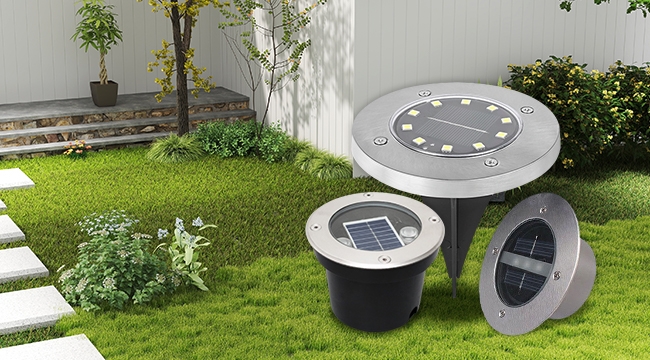Solar in-ground lights have become a favorite choice for homeowners who love eco-friendly, low-maintenance ways to brighten their gardens, pathways, and driveways. They're elegant, energy-saving, and easy to install—no wires, no electricity bills, and no complicated setup. You just place them where you want light, and the sun does the rest. But one common question always pops up: Can solar ground lights be used in shady areas? At first glance, it seems like a simple yes or no question. After all, solar lights depend on sunlight to charge, so if there's shade, won't that be a problem? Let’s explore how solar buried lights behave in shady environments.

How Solar In-Ground Lights Work?
To understand whether they can perform well in shady areas, it's important to first know how solar garden ground lights operate. Each solar light is typically composed of the following parts:
- Solar panel. A solar panel that captures sunlight and converts it into electrical energy.
- Battery. A rechargeable battery that stores this energy during the day.
- Lamp beads. Lamp beads that use the stored energy to illuminate your space at night.
During the day, the solar panel absorbs sunlight and charges the battery. Once the sun sets, the light automatically turns on, powered entirely by the energy stored earlier. The brighter and longer the sunlight exposure, the better the battery charge, and the longer the lights will stay on at night. So, logically, if your solar ground light sits in a completely shaded spot, under dense trees or next to tall walls, it won't receive enough sunlight to fully charge.
Types of Shade:
Not all shade is created equal. Some areas only experience partial shade, while others barely get a hint of direct sunlight. The type of shade you're dealing with will affect how well your solar lights perform.
Full Sun. An area that receives at least 6 hours of direct sunlight daily. Solar lights will perform best here, offering bright illumination all night long.
Partial Shade. Areas that receive 3–5 hours of direct sunlight per day and are shaded the rest of the time fall under partial shade. In such locations, solar ground led lights can still work fairly well if they have high-efficiency solar panels and large-capacity batteries.
Dappled Shade. This refers to areas where sunlight filters through tree leaves, producing a pattern of light and shadow. Dappled shade reduces sunlight intensity but doesn't completely block it. Solar lights can still charge, although more slowly.
Full Shade. Full shade means little to no direct sunlight, such as under dense foliage or beside tall structures. In such cases, solar lights will struggle to charge properly and may not function as intended.

Factors That Affect Solar Lights Performance in Shade:
Solar ground garden lights rely on direct sunlight to charge their built-in batteries through photovoltaic panels. When placed in shaded areas, their performance can be affected by several key factors. The first factor is the amount and duration of sunlight exposure. Even partial shade from trees, fences, or nearby buildings can significantly reduce charging efficiency. Solar panels need at least 6 to 8 hours of direct sunlight daily for optimal performance. Another important factor is the quality and sensitivity of the solar panel itself. Additionally, battery capacity and condition play a role, a larger or newer battery can store more energy, helping the light last longer at night even with limited daytime charging.
Environmental conditions also influence solar light performance in shade. Weather patterns, such as frequent cloud cover or rain, further reduce the available sunlight for charging. Placement angle is another factor, panels that are slightly tilted toward the sun can capture more diffuse light than flat ones. Moreover, cleanliness of the panel surface affects light absorption; dust, leaves, or bird droppings can block sunlight and lower efficiency. Finally, temperature fluctuations impact battery efficiency, as extreme cold or heat can shorten lifespan or reduce charging power.
Tips for Using Solar Ground Lights in Shady Areas:
If your garden or yard has shaded spots, don't worry—you can still enjoy the beauty and convenience of solar in-ground lighting. It just takes a few smart strategies.
- Choose high-efficiency solar lights. Not all solar lights are built the same. Some use advanced photovoltaic panels and high-capacity lithium batteries that perform well even in lower light conditions.
- Angle the panels properly. Sometimes a small adjustment makes a big difference. Tilting the solar panel slightly toward the direction of the most sunlight can help maximize energy absorption, especially in areas that only get morning or afternoon light.
- Trim overhanging branches. Trees are lovely, but their thick leaves can block sunlight. Trimming a few branches can significantly improve light exposure without compromising the beauty of your landscape.
- Keep the panels clean. Dust, dirt, and debris can reduce solar absorption, which is especially critical in shaded areas where every bit of sunlight counts. Wipe the panels with a soft cloth every couple of weeks to keep them performing efficiently.
Conclusion:
So, can solar in-ground lights be used in shady areas? The answer is yes, but with some limitations. While these lights perform best in full sunlight, they can still function in partially shaded locations if you choose high-quality models, optimize their placement, and maintain them properly. With a little creativity—like relocating panels or trimming branches,you can still enjoy the warm, inviting glow of solar lighting, even under the trees. Each area has different conditions, so it's important to analyze specific situations accordingly. However, it's still recommended to install solar powered ground lights in areas where they can receive sufficient sunlight to achieve the best performance. If you have any further questions about solar ground lights, please feel contact us, and Inverter Online Shop will do our best to assist you.
